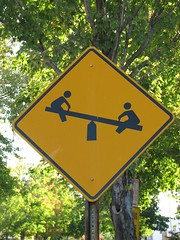Finally! Here’s an explanation of mindfulness meditation and the practice of mindfulness in general. The post is long but worth sticking with. (I think so at least!)
Mindfulness = Paying Attention
Mindfulness is captured by simple terms:
- Paying attention
- Being, not doing
- Present moment awareness
- Being “here”
Easy ideas, complicated concepts. The ubiquity of multitasking is an excellent example of the challenges. Home, work, play, school, friends, family… There’s so much to think about and it all fights for attention. With our minds everywhere at once, they are often far from our actual lives.
The UCSD Center for Mindfulness, part of the medical school’s psychiatry department, gives this definition:
[Mindfulness] is a quality, which human beings already have, but they have usually not been advised that they have it, that it is valuable, or that it can be cultivated. Mindfulness is the awareness that is not thinking (but that which is aware of thinking, as well as aware of each of the other ways we experience the sensory world, i.e., seeing, hearing, tasting, smelling, feeling through the body).
Mindfulness is non-judgmental and open-hearted (friendly and inviting of whatever arises in awareness). It is cultivated by paying attention on purpose, deeply, and without judgment to whatever arises in the present moment, either inside or outside of us. By intentionally practicing mindfulness, deliberately paying more careful moment-to-moment attention, individuals can live more fully and less on “automatic pilot,” thus, being more present for their own lives.
How is mindfulness part of meditation?
Meditation can be broken into two basic categories: Concentration and mindfulness. Until my recent introduction to mindfulness, I’d always thought of meditation as concentrating on clearing one’s mind or focusing on a narrow idea. To me, mindfulness seems the opposite.
What I love about Western medicine’s approach to mindfulness meditation is the focus on becoming aware of your body, to be rooted in what you are experiencing. Having felt that my body has “betrayed” by giving me migraine and chronic daily headache, I am amazed by all the good it does.
That said, mindfulness meditation also involves paying attention to negative sensations (i.e. pain). I’ve long been a fan of burying my nose in a book to distract myself. Paying attention to the pain, nausea and vertigo is indescribably difficult. I get frustrated nearly every time. Tears and yelling are not uncommon. But I keep practicing and, like with any knew skill, it becomes a little easier each time.
This approach fully acknowledges that the mind wanders. In fact, one of the CDs I use says that the nature of the mind is to wander. Thinking of it this way makes it easier to let the thoughts go and return to the practice. There’s a non-judgmental quality to it and one that I, with practice, am learning to accept.
Think it’s not for you? Think again.
If I can do it, anyone can. Seriously. I have only be involved with it for two months, but my health has already benefited. The definition I provide from the UCSD Center for Mindfulness is rather academic, but my experience hasn’t been. You’ve probably caught on by now that practice is key. I started with, and still use, a 20-minute CD segment. I feel my body relax as I progress and am always surprised when it ends.
The point of all this is not “enlightenment,” but better health. I now notice when I start to feel flushed, which is usually the beginning of a crash. Sometimes I push, but sometimes I stop. In the airport recently, the rigmarole, crowds and general feeling of being rushed got to me. All I did was sit down and breathe and felt better within 10 minutes. I also thought of a small step I could take to ensure I stayed calm: I could pre-board. Boy, did that help.
Want to join me?
I already know that mindfulness will become an integral part of my treatment. As such, it will likely become a main topic on The Daily Headache. You can follow along with my experience and may even want to join me. I’d love to get a dialog going where we can learn from each other.
Resources
I’ve found some websites with good introductions to mindfulness and mindfulness meditation. Some get kind of abstract and spiritual sounding, but try to think of how it can apply to your health and self-care. Following links about mindfulness-based stress reduction (MBSR) may be helpful.
- UMass Center for Mindfulness in Medicine, Health Care and Society
Where it all began. The site isn’t very descriptive but it gives you an idea of the application to medicine. - UCSD Center for Mindfulness
The MBSR course is similar to the one I was in the last two months. There is probably a course like it near you. - Shambhala Sun
Mindfulness meditation articles from a Buddhist magazine
For books, I recommend starting with Full Catastrophe Living: Using the Wisdom of Your Body and Mind to Face Stress, Pain and Illness. Basically a book version of UMass’s Stress Reduction Clinic’s program, it takes a strong Western approach. It reads like the self-help book it is, yet has great information. You’ll help support The Daily Headache if you buy it through the link above or you can probably get it at your library.

